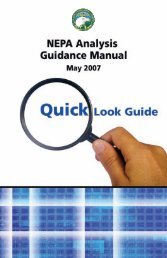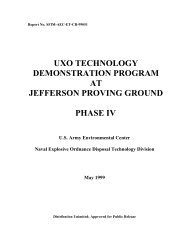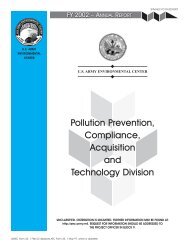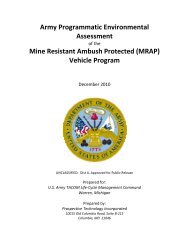range xxi - U.S. Army Environmental Center
range xxi - U.S. Army Environmental Center
range xxi - U.S. Army Environmental Center
You also want an ePaper? Increase the reach of your titles
YUMPU automatically turns print PDFs into web optimized ePapers that Google loves.
6<br />
PURPOSE<br />
BENEFITS<br />
TECHNOLOGY USERS<br />
ACCOMPLISHMENTS AND RESULTS<br />
LIMITATIONS<br />
FIELD ASSISTANCE SUPPORT AND TECHNOLOGY<br />
TRANSFER TEAM<br />
The Field Assistance Support and Technology Transfer (FASTT) team is a<br />
pollution prevention (P2) and environmental field assistance team initiated<br />
by the Navy. FASTT can help operations and maintenance personnel meet<br />
environmental requirements while performing their missions on schedule<br />
yet at a lower cost. Since its inception, the team has grown in its<br />
membership and site evaluations. The FASTT team consists of members<br />
from the Navy, <strong>Army</strong> (including the U.S. <strong>Army</strong> <strong>Environmental</strong> <strong>Center</strong>),<br />
Air Force and Marines.<br />
The FASTT mission is to reduce the cost of environmental compliance<br />
and improve maintenance work processes utilizing the best technology and<br />
management practices available. P2 plans and updates are required of all<br />
<strong>Army</strong> installations by <strong>Army</strong> Regulation 200-1 and Executive Order 13148.<br />
Sound environmental planning involving pollution prevention has been<br />
deemed the most economical and practical means of addressing<br />
environmental compliance concerns. Identifying pollution prevention<br />
opportunities at installations will assist in efforts to comply with <strong>Army</strong><br />
mandates as well as legal requirements. Since the site report contains cost<br />
benefit data, it can serve as an addendum to your P2 plan. Emphasis is<br />
placed on finding, developing and implementing only those material<br />
substitutions, work process changes and technology acquisitions that will<br />
decrease the burden on the serviceman.<br />
<strong>Army</strong> FASTT team members coordinate visits at participating <strong>Army</strong><br />
installations. All site surveys are scheduled through the activity<br />
environmental offices. Once an installation is selected, a small team visits<br />
the activity to conduct a pre-survey. This enables the FASTT team to<br />
formulate a team best suited to meet the activity’s needs. A few weeks<br />
later, a FASTT team will return to conduct the site survey. At the exit<br />
briefing with the activity commanding officer, the team presents a written<br />
report targeting opportunities for maintenance process improvement,<br />
waste reduction and cost avoidance. The ideas and suggestions in the<br />
report can be used to reduce business costs through reductions in waste<br />
streams, labor, and costs associated with environmental compliance.<br />
<strong>Army</strong> installations and major <strong>Army</strong> commands as well as other service<br />
(Navy, Air Force and Marines) members.<br />
To date, more than 48 sites have been visited, and recommendations have<br />
been made with an estimated cost savings approaching $200 million.<br />
All recommendations made during an <strong>Army</strong> site visit are left to<br />
installation personnel to initiate and prioritize based on available resources<br />
and need unless otherwise indicated in the report. Each service handles the<br />
recommendations somewhat differently. For instance, in the Navy, all







